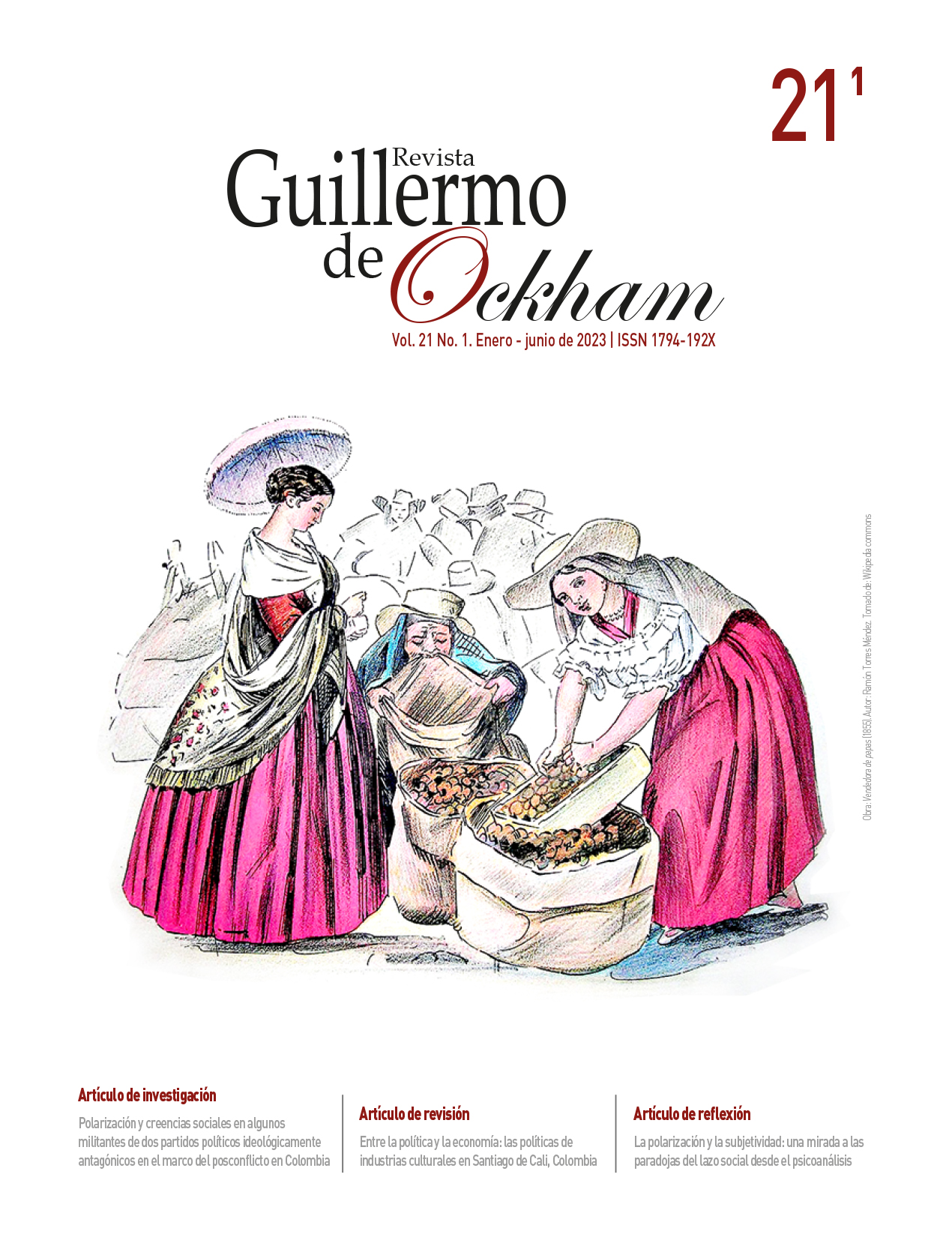The Revista Guillermo de Ockham provides an immediate and open access to its content, based on the principle of offering the public a free access to investigations to provide a global interchange of knowledge.
Unless otherwise established, the contents of this journal has a license with Creative Commons Attribution-NonCommercial-NoDerivatives 4.0 International (CC BY-NC-ND 4.0) http://creativecommons.org/licenses/by-nc-nd/4.0/
- Attribution: You must give appropriate credit, provide a link to the license, and indicate if changes were made. You may do so in any reasonable manner, but not in any way that suggests the licensor endorses you or your use.
- NonCommercial: You may not use the material for commercial purposes.
- NoDerivatives: If you remix, transform, or build upon the material, you may not distribute the modified material.
- No additional restrictions: You may not apply legal terms or technological measures that legally restrict others from doing anything the license permits.
Abstract
The purpose of this essay is to anthropologically interpret the messages and images of the flyers distributed in the streets to advertise the consumption of love magic. Its content is described and systematized, the role played by those who carry out the rituals and the loving ideals spread by those who market these cultural products is interpreted. The methodology focuses on the contrast of one hundred flyers collected in some colombian cities, during the last eight years. It was found that the street advertising of love magic is focused on the ritual of the mooring, which is not only desired by popular sectors, or by women exclusively, and that this resource of love assistance is frequented by various socioeconomic sectors of the population society; since each one finds administrators of the magical according to their respective cultural capitals. Love is one of the areas that deserves more attention in everyday life; in general terms, maintaining loving and sexual ties with a particular partner is a sophism of happiness and security for many people. The ritual of the mooring represents symbolic violence related to humiliation and domination. This topic is relevant since it innovates in the study of magic and religious syncretisms, by studying what the flyers say that offer the possibility of solving abandonment and infidelity through the resource of secret and distance mooring.
Keywords:
References
Augé, M. (1993). El genio del paganismo. Muchnik.
Bauman, Z. (2005). Trabajo, consumismo y nuevos pobres. Gedisa.
Bauman, Z. (2009). Amor líquido: acerca de la fragilidad de los vínculos humanos. Fondo de Cultura Económica.
Cámara de Comercio de Bogotá. (2022). Descripción actividades económicas (Código CIIU). https://linea.ccb.org.co/descripcionciiu/
Castellanos, S. (2009). Diosas, brujas y vampiresas: el miedo visceral del hombre a la mujer. Norma.
Castro Caycedo, G. (2010). La bruja: coca, política y demonio. Planeta.
Dawkins, R. (Escritor y presentador). (2007). The enemies of reason [Documental]. BBC Documentary.
Frazer, J. G. (1981). La rama dorada: magia y religión. Fondo de Cultura Económica.
Ginzburg, C. (2008). El queso y los gusanos: el cosmos de un molinero del siglo XVI. Ediciones Península.
Haber, A. (2011). Nometodología payanesa: notas de metodología indisciplinada (con comentarios de Henry Tantalean, Francisco Gil García y Dante Angelo). Revista Chilena de Antropología, (23), 9-49. https://revistadeantropologia.uchile.cl/index.php/RCA/article/view/15564
Han, B. C. (2014). La agonía del eros. Herder.
Juez, F. M. (2002). Contribuciones para una antropología del diseño. Gedisa.
Lara, K. (1993). Recetario de magia blanca: fórmulas para resolver los problemas que lo atormentan. Editorial Colombia Nueva.
Leach, E. (1985). Cultura y comunicación: la lógica conexión de los símbolos. Siglo XXI.
Lévi-Strauss, C. (1995). Antropología estructural. Paidós.
López, R. (2019, 2 de febrero). Ramiro López el Chamán Llanero “Cura para el alma” Canal RCN. YouTube. https://www.youtube.com/watch?v=wXAEaVxP8jI
Ocampo, J. (2008). Supersticiones y agüeros colombianos. El Áncora Editores.
Pinzón, C. E. (1998). Violencia y brujería en Bogotá. Boletín Cultural y Bibliográfico, 25(16), 35-49. https://publicaciones.banrepcultural.org/index.php/boletin_cultural/article/view/2792
Pinzón, C. E., y Garay, G. (1997a). Las nuevas construcciones simbólicas en América Latina: entre lo local y lo global. ECSA.
Pinzón, C. E., y Garay, G. (1997b). Violencia, cuerpo y persona: capitalismo, multisubjetividad y cultura popular. ECSA.
Quintero, P. (1994). El Chamán Paéz [Tesis de grado, Universidad del Cauca]. Universidad del Cauca.
Quintero, P. (2016, 2 de abril). La magia amorosa promocionada en volantes. Blog de Antropología Simbólica y Literaria. https://etnicografica.wordpress.com/2016/04/02/la-magia-amorosa-promocionada-en-volantes/
Sagan, C. (1998). El mundo y sus demonios: la ciencia como una luz en la oscuridad. Planeta.
Sanabria, F. (2007). ¿Creer o no creer?: he ahí el dilema. En C. Tejeiro, F. Sanabria y W. M. Beltrán (Eds.), Creer y poder hoy (pp. 61-73). Universidad Nacional de Colombia.
Taussig, M. (2012). Chamanismo, colonialismo y el hombre salvaje: un estudio sobre el terror y la curación. Editorial Universidad del Cauca.
Uribe, C. A. (2003). Magia, brujería y violencia en Colombia. Revista de Estudios Sociales, (15), 59-73. https://doi.org/10.7440/res15.2003.04
Uribe, C. A. (2008). El yajé, el purgatorio y la farándula. Antípoda, (6), 113-131. https://doi.org/10.7440/antipoda6.2008.06
Vargas, C. (2004). La llorona [Canción]. En La llorona [Álbum]. RCA Records.
Zuleta, E. (1999). El elogio a la dificultad y otros ensayos. Editorial Hombre Nuevo.

































